Orange Acoustic Pedal demo by our friends over at Jam in the Van.
“Does the Orange OR30 feel good?” Spoiler alert: The answer is yes. We asked our friends over at Jam in the Van to demo and give us their thoughts on the OR30 and this is the result. It feels good, sounds good, and looks good.
Guitar amplifiers are an essential component of any guitarist’s setup. They help shape the tone and provide the necessary volume to make your guitar sound great. However, with so many options available in the market, choosing the right amplifier can be a daunting task. In this blog post, we will guide you through the important factors you should consider when choosing to purchase a guitar amplifier.
Type of Amplifier
The first thing you need to consider when buying a guitar amplifier is the type of amplifier you want. There are two main types of guitar amplifiers: tube amps and solid-state amps. Tube amps use vacuum tubes to amplify the guitar’s signal, producing a warm and natural tone. Solid-state amps, on the other hand, use transistors to amplify the signal, producing a more crisp and clean sound. Each type of amp has its own unique tone, and the one you choose will depend on your personal preferences and the genre of music you play.
Wattage
The wattage of an amplifier determines how loud it can get. A higher wattage amplifier will produce more volume than a lower wattage amp. However, it’s important to note that higher wattage amps are not always necessary. If you’re just playing at home or in a small venue, a lower wattage amp will do just fine. On the other hand, if you’re playing in a large venue or with a loud band, you’ll need a higher wattage amp to cut through the mix. Solid-state amps tend to have a uniform sound/tone quality throughout their volume range. A tube amp however will change tonal characteristics as the volume is increased and the output tubes driven harder. It is often said that tube amps have a sweet-spot. Therefore, choosing too much wattage will mean you can’t turn up loud enough to achieve the sweet-spot in small venues or during home use and too little power means you will be constantly overshooting this point in an attempt to hear yourself in large or loud settings.
Features
Amplifiers come with a variety of features that can affect your playing experience. Some amplifiers come with built-in effects such as reverb, delay, and distortion, while others are more straightforward and focus solely on amplification. If you’re a beginner, a simpler amplifier may be more suitable for you, while more experienced players may want an amp with more features.
Portability
If you’re going to be gigging or traveling with your amplifier, portability is an important factor to consider. A smaller, lightweight amplifier may be easier to transport, while a larger, heavier amplifier may provide better sound quality. If you’re not planning on moving your amplifier around, then this factor may not be as important to you.
Price
Finally, you should consider the price of the amplifier. Amplifiers can range from a few hundred dollars to several thousand dollars. While it’s important to choose an amplifier that fits your budget, it’s also important to remember that you get what you pay for. Cheaper amplifiers may not have the same sound quality or durability as more expensive amplifiers. A tube amp will require additional maintance over a solid-state amplifier – at some point or another there is likely to be a time when the tubes need replacing. Like car tyres, the more aggressively they are used the quicker they will wear. Sometimes they fail prematurely like a tyre puncture.
In conclusion, choosing the right guitar amplifier can be a difficult task, but by considering the type of amplifier, wattage, features, portability, and price, you’ll be able to make an informed decision. At Orange Amps, we offer a wide variety of amplifiers to suit all types of players, so be sure to check out our selection and find the amplifier that’s right for you.
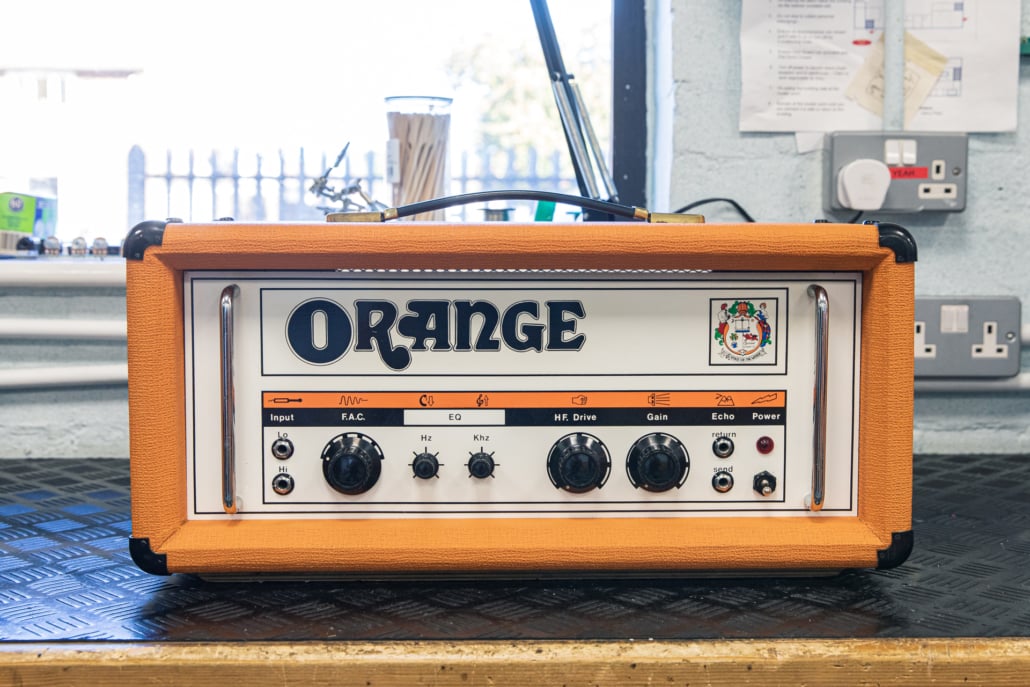
Over the past month, we’ve been taking care of an original Orange OR120 head from 1974 that was sent in by its owner for a tune-up before being passed down to their son. In the previous entries, we’ve had a look at the unit’s history and legacy, as well as how we’ve fixed it up for use in the modern age. Now, it’s time for the ultimate proof of the pudding — plugging in a guitar. All guitar sound samples in this post were recorded on a PJD Carey guitar with a single-coil pickup at the neck and humbucker pickup at the bridge.
NO PRISONERS
The first thing to say about this amp is that it’s LOUD. Like, incredibly loud — louder than any modern Orange amp by quite some margin, to the extent that it is perhaps even less of a mystery now why so many 1960s and 70s rockers are suffering hearing loss in their dotage. We ran it through an Orange PPC412 speaker cabinet at about one-third volume in a space about the size of an average rehearsal room, and it was already dishing out instant bouts of tinnitus, and demanding ear defenders all round. Given that the amp’s sockets allow for the connection of two speaker cabinets, too, the potential of this beast is massive.
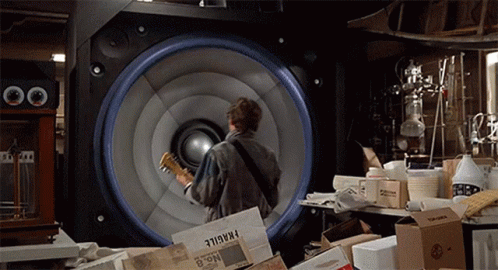
That sheer muscle is perhaps an indication of the era in which the amp was designed and built, before the age of complex, high-powered PA systems in the early 80s but shortly after the arrival of stadium rock and the outdoor music festivals of the early 70s (the original Woodstock was August 1969 and the first Glastonbury June 1970, for example). During that time, bands were largely expected to bring their own noise, and not to expect much in the way of a boost from a PA system. And with that in mind, the OR120 rigged up to a couple of 4×12 speaker cabinets would have no problem in filling huge spaces.
What’s more, with stage monitoring technology still very primitive back in the early 1970s, there was an expectation that you needed to be able to hear your playing directly from your amp on stage, even if it was 50 feet away and there was a rhythm section smashing away in between you and it. The OR120’s power could deliver all that with confidence, and was clearly designed specifically for that.
How the amp achieves this volume is mainly down to the huge 500 V voltage in its circuit, which is far greater than modern amps and will offer miles more clean headroom. Four power valves and a simple pre-amp circuit that doesn’t subtract too much gain from the signal also helps. There are also fewer tone stacks in the OR120 than a lot of its successors in the Orange range, which would account for less gain loss through the signal chain.
The amp’s tone is also an interesting indicator of its age. With all dials set to the middle, it’s remarkably clean and chiming, with plenty of heft and three-dimensionality, if not quite the character of Orange amps of the new millennium.
TONE-SHAPING
However, the unusual F.A.C. control, a six-point notched dial that subtracts increasing amounts of low end from the tone, has a huge impact in shaping the tone, making the sound increasingly brittle and bright as it’s introduced. At its farthest extreme, this sounds piercingly trebly to modern ears, but revisiting the records of the second half of the 60s and early 70s by the likes of the Beatles and the Byrds, for example, reveal this to be the sound of contemporary guitar music, suggesting Orange to be on the cutting edge, as ever.
When the F.A.C. is combined with higher gain and into overdrive territory, however, it adds a definition to the tone that counterbalances the slightly muddiness of the basic overdriven sound, and proves to be an invaluable component of the amp’s tone-shaping toolbox.
The two-band EQ is also surprisingly powerful, with the range of both knobs allowing considerable variety to the shape of the sound and consequent versatility, presumably another feature included with the idea of helping the guitarist onstage with a noisy band around him. Similarly, the HF. Gain knob has slightly more subtle control, moulding the mid–high tones in much the same way as a modern-day presence control would, but its interaction with the gain knob is still well incorporated.
OVERDRIVE
Another interesting sign of the times, tonally, comes in the form of the OR120’s only modest overdrive capabilities: the amp’s noticeably clean chime only starts to break up as the gain is pushed up beyond about three-quarters, and there’s a lot of “edge-of-breakup” territory where the tone’s fuzz is largely dictated by the player’s technique. Furthermore, the absence of a master volume knob means that you have to be playing through the amp at an exceptionally loud volume before any semblance of break-up or overdrive emerges. Even at full gain, though, it’s a long way from the fully saturated tube screamers of the 1990s and beyond, and retains more of a British punk/Sex Pistols sound, with grit and ferocity, but also quite crisp (although whether the likes of the Steve Jones, who famously stole his early instruments, ever got his mitts on an OR120, is a moot point).
This marks the OR120 as an interesting artefact of rock music history: even in 1974, when this amp was made, three years after Led Zep IV and Paranoid had ushered in the dawn of heavy metal and huge-sounding rock music, guitar tones remained fairly polite, and the appetite for extreme howling overdrive was still clearly in its early infancy. Understanding that somewhat recontextualises those classic albums as real sonic boundary-pushers, and also serves as a reminder that the bloom from crunch into thrash and total saturation would take another few years — and perhaps the introduction of a master volume control. And we’ll have to wait for another Orange relic to arrive on the bench before we dig into that.
A couple of weeks ago, a fairly special old amp arrived at the Orange workshop — namely an original Orange OR120 from 1974 — in fantastic condition considering its age. The owner explained that it had been in storage for a while and wanted it returned to its former glory, so we were only too happy to oblige. In the previous blog entry, we looked a bit at the OR120’s history and legacy, as well as this particular specimen that’s been sent in. Today, with our head technician Jon having worked his magic on the old thing, we have a look at what needed doing to it and why, and how we got it ready to play again.
WHAT WAS FIXED, AND WHY
What should be said first is how little needed fixing on this 48-year-old amp: the circuitry, transformers and choke have all stood the test of time perfectly, which could be said to be a testament to Orange’s sustainability.
Some parts did need swapping out for new ones, but thankfully these are relatively inexpensive and still easy to come by. Perhaps the most important and easiest change was the valves — both the pre-amp valves (a pair of ECC83s) and the power-amp section (a quartet of EL34s). The pre-amp valves had become “microphonic” over time, meaning that they had grown undesirably hypersensitive to noise, and the power-amp ones are no longer matched, drawing differing amounts of current during use and therefore inhibiting the consistency of the amp’s performance. These valves just needed swapping out of their sockets, and new ones putting in their place.

The other main change was to the amp’s electrolytic capacitors. A little like rechargeable batteries, capacitors’ abilities to store electric charge declines unavoidably over time, and 48 years is a good innings for one of these specimens! When they start to lose their efficacy, the sonic effect is a flat, undynamic response from the amp, and an increase in “ripple” — a jagged, distorted sound (and not in a good way), and a constant buzzy hum. Changing over the capacitors required a little more technical skill with a soldering iron and a steady hand, but thankfully our tech Jon was on hand:
Jon swapped over ten capacitors in total: two can capacitors in the first of the filtering stages, two bypass capacitors, two in the bias circuit and four for the remaining filtering stages.
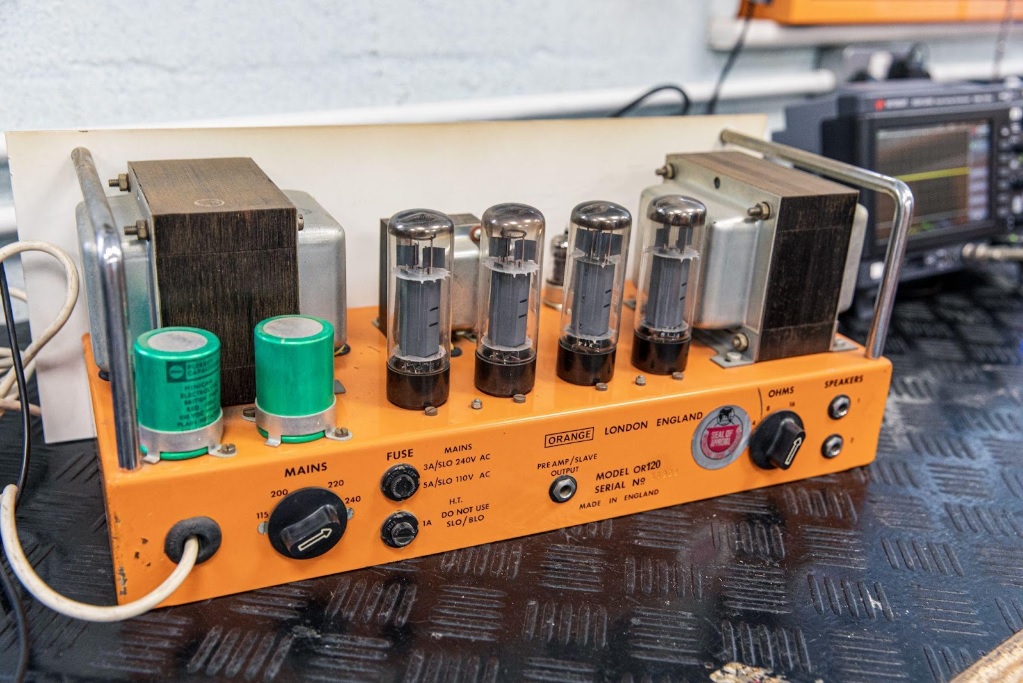
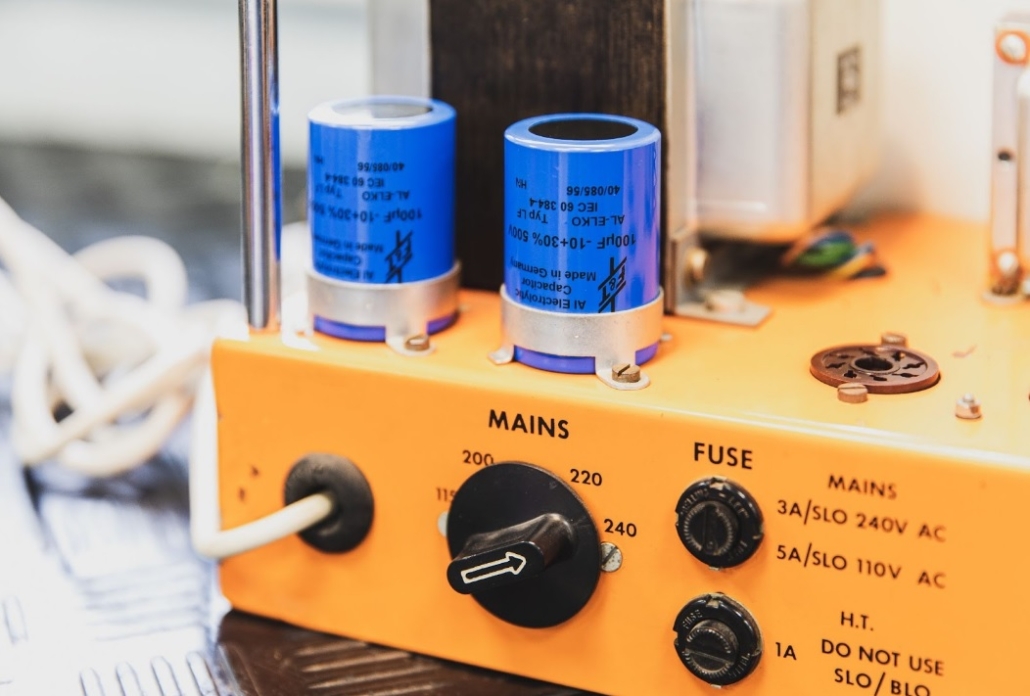
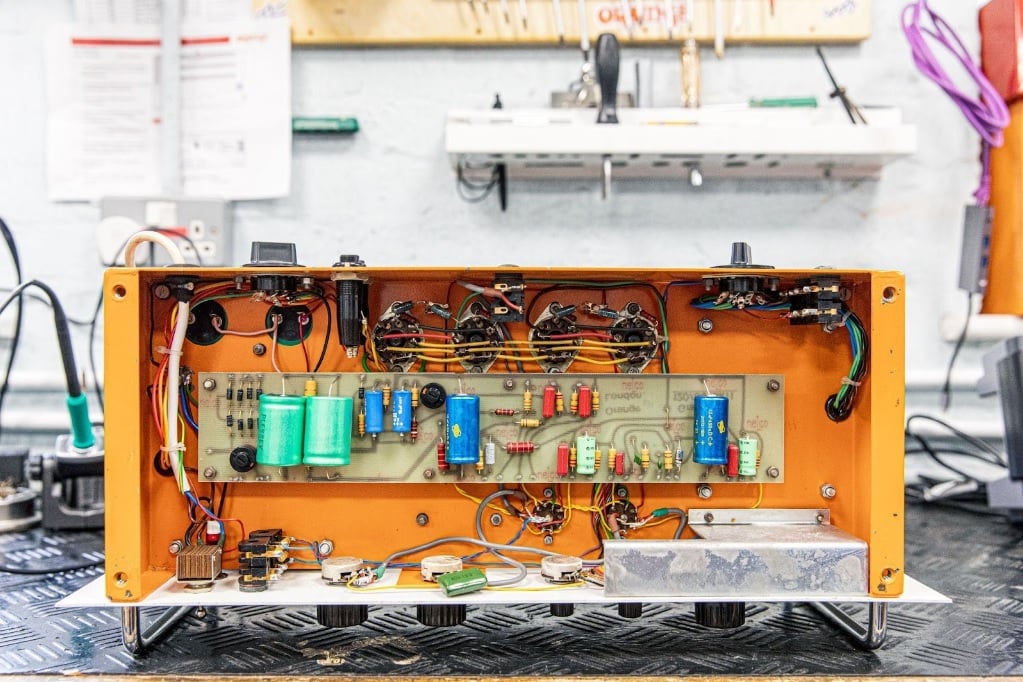
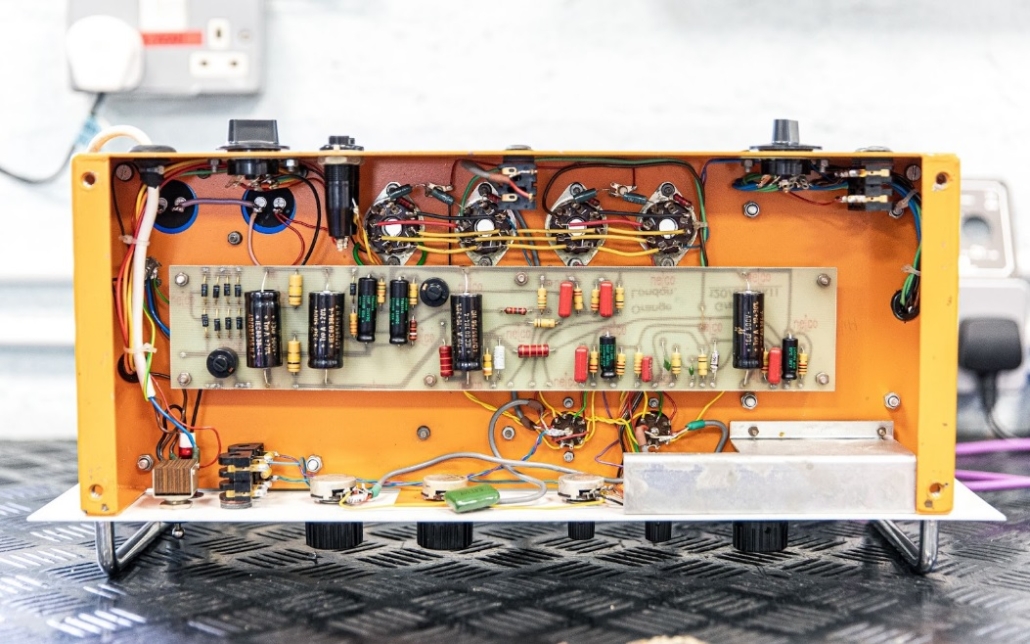
The eagle-eyed will spot that it’s not only the colour, but also the size and shape of the new capacitors that differs from those of the 1970s originals. However, in terms of their spec, it’s an exact like-for-like swap; the modern, slimmed-down versions are just a result of technical and manufacturing improvements over the past half-century.
GETTING IT READY TO PLAY AGAIN
Normally, when a vintage amp arrives in the workshop that hasn’t been switched on for several years, it’s good practice to gently reintroduce voltage using a variable transformer (the “variac”) that allows the user to vary the number of volts entering a system. Starting at zero and slowly increasing the number over a number of hours, it ensures that an old system isn’t given too much of a jolt, and subsequently overloaded, on its first resurrection.
When this particular OR120 first arrived, it was clear that enough needed changing that it wasn’t necessary to turn it on before the first fixes: the capacitors were visibly blistered, and the valves were not performing ideally on a valve tester. However, once the unit had been returned to its full working condition, it was crucial to run it through the variac, gently upping the voltage over the course of an afternoon, while keeping an eye on the current it was drawing, before actually putting an electric guitar through it — a treat that will have to wait until next time.
COMING NEXT TIME: How the refurbished OR120 sounds when returned to its former glory, complete with audio samples
Gear moves in and out of the Orange workshop pretty constantly, with fixes, mods and inspections to amps, pedals and prototypes all in a day’s work. Very occasionally, though, something gets sent in that makes us crowd around the workbench — something rare, old, or unusual, or just something we’ve only ever read about before.
One of these occasionallys happened last week: an amp head showed up at Orange HQ wrapped in a home-sewn leather cover with an accompanying note from the original owner. The amp had been kept in storage for a while, the note explained, but now the owner was looking to give it to his son, a promising guitarist. Before he did that, though, he wanted to have the unit looked at by our expert technicians, and so here it was with us.
But this head in question isn’t just any old Orange relic. Removing the cover revealed an early-manufacture OR120, also known as the Orange Graphic 120 — the model that has a decent claim to be the foundation stone of the Orange sound as we now recognise it, well into its sixth decade.
The serial number dated this unit to 1974, barely five years after Orange was founded, and only two after the company began serious mass production with its first factory in Kent. The OR120 was a year-zero moment for Orange: a wholesale rejigging of the existing schematics, from which emerged a new tone that everybody would come to associate with the brand, with a design and sound that would influence the amp world, both Orange’s and other’s, ever since. And here was one of the beauties, right in front of us on the bench!
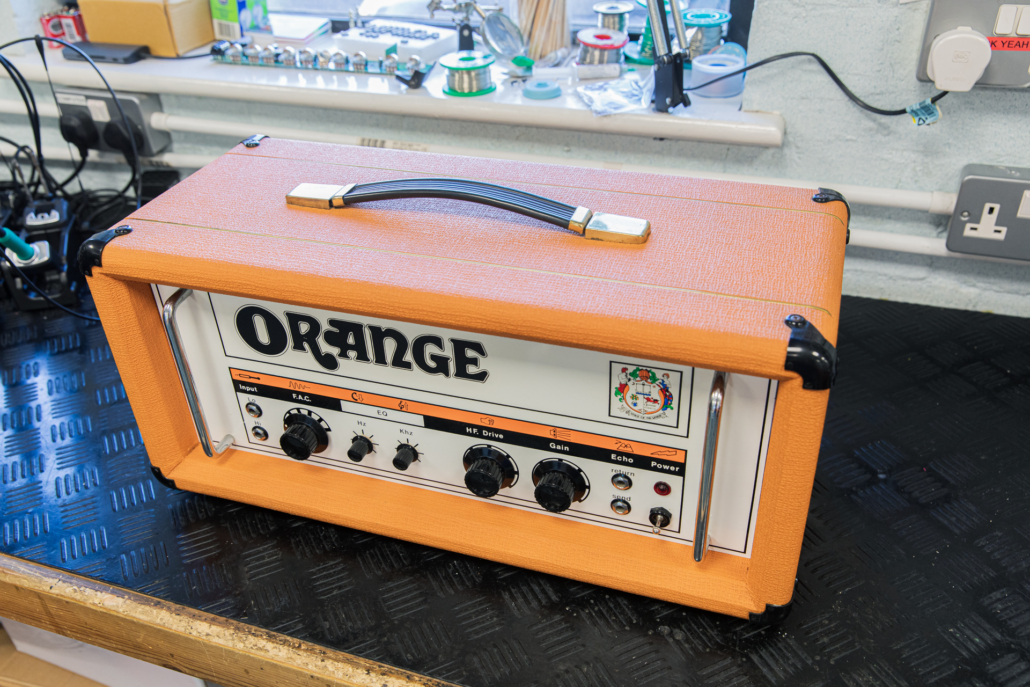
BEGINNING OF A DESIGN EVOLUTION
The first thing that leaps out about the looks of OR120, when viewed through 2022 eyes, is how much of a snapshot it is of the young Orange in 1974, on the cusp of a breakthrough. Sure, there’s the none-more-70s brass handle bolts and gold trim, both of which would become black in future iterations, but the threshold-of-greatness status is perhaps best observed through the amp’s controls, and specifically how much (and how little) things have changed in the past 48 years: superficially, the layout on the OR120 is much the same as its modern-day successors, but look a little closer, and interesting differences emerge.
There’s a knob marked F.A.C. (supposed to stand for Frequency Attenuator Control, or is that Frequency Adjustment Circuit?), actually a six-point notched dial that subtracts increasing amounts of low end from the tone, and the two treble and bass dials marked just “KHz” and Hz”, respectively. Along with another marked “HF. Drive”, it suggests an amp being labelled up for an end user who already understood scientific terms and was comfortable with undescribed acronyms.
Alongside that, though, was one of the first outings of the soon-to-be-famous Orange hieroglyphs, with a charming accidentally reversed bass clef symbol to represent the low end, and the now-familiar clenched-fist symbol to indicate what future amps would simply call “punch”.
The amp also serves as something of a Rosetta Stone for some of the less straightforward icons too. Ever wondered, for example, why twin mountain peaks represents an effects loop? The OR120 might have an answer: the pair of sockets through which the user could connect an external reverb unit was marked “Echo”, illustrated with the classic mountain scene.
Suddenly, sound bouncing off an alpine canyon makes perfect sense. Those pair of sockets would eventually migrate to the back of many an Orange amp, and the “echo” be broadened out to include any manner of external effects units, but the hieroglyph never changed, perhaps because it spoke a language never grounded in words: these symbols seemed to want to reach new players unbothered by scientific jargon, who wanted a universal language of guitar tone — and the circuitry spoke to that, too.
UNDER THE HOOD
We’d all seen pictures of the outside of the OR120 before this example arrived in the workshop. But perhaps the most interesting aspect of having one to investigate in the flesh was popping off the sleeve and seeing the creature’s guts. And what a perfectly clean, immaculately preserved example of an OR120 we had here, with the circuitry and build serving as an absolutely textbook example of how to construct an amp in 1974.
Unfortunately, the valves had had become unmatched over the years, so that they were drawing differing amounts of current to one another — a simple function of old age — and the original Plessey capacitors, proudly stamped with “British Made”, needed replacing. However, what the meticulous attention to detail shows is how these heads were built to last.
LEGACY
And last they did, with a build quality and sonic popularity to give them decades of acclaim. A 1974 ad in the trade press reveals them to have retailed at £140 (about £1,200 in today’s money), with earnest insistence that “good value and reliability ensure your customers return”.

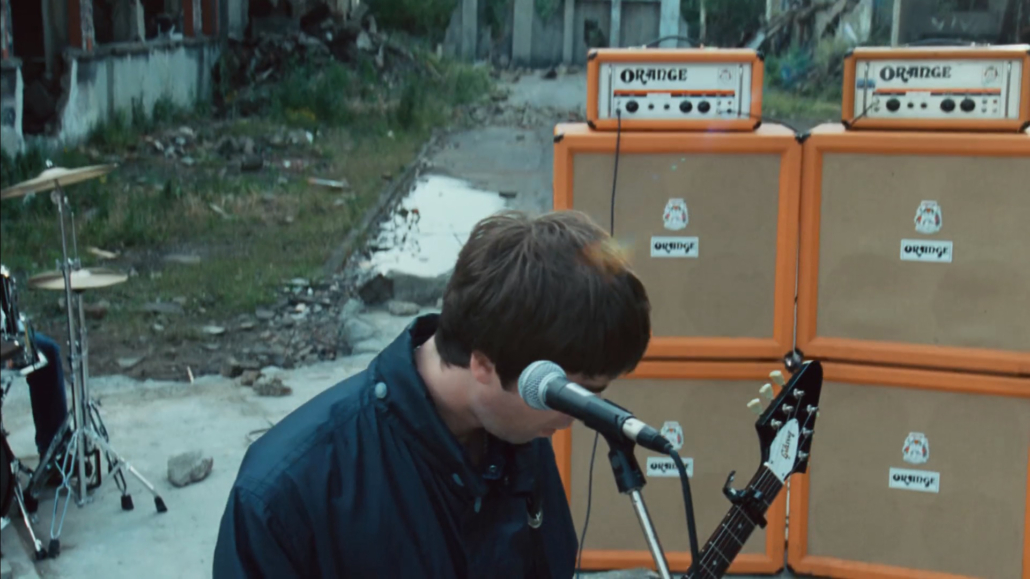
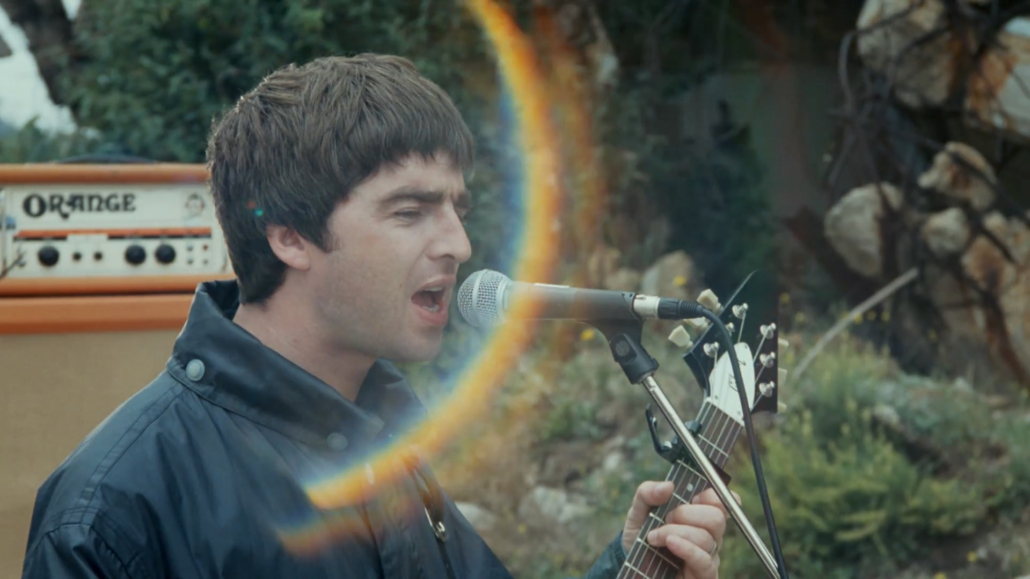
Indeed, it’s testament to the OR120’s tonal longevity that 23 years after they were first introduced, they had perhaps their most eye-catching role: when Oasis revealed the video accompanying the number-one single D’You Know What I Mean from their third, victory-lap album Be Here Now in July 1997 (still the fastest-selling rock album in British chart history, amazingly), a pair of re-issued OR120s sat proudly on their own Orange double 4×12 stacks behind Noel Gallagher (see the screengrabs from the video, above).
Full of epic rock bombast — helicopters, crowd riots and aerial photography — it was the most expensive music video made by the UK’s last genuinely household-name rock band, and amid all the grey concrete and khaki parkas elsewhere in the video, that pair of bright orange monoliths stand proud. And so they should.
COMING NEXT TIME: What fixes were done to this OR120, and how it sounded when returned to its former glory
Ordinarily, the world of school physics lessons is a million miles from guitar heroics (unless, of course, you’re Angus Young and wear the same outfit for both). However, if there’s a place where they overlap, it’s on the back of your amp and speaker cabinet — and knowing what those scientific symbols and warnings written beside the jack sockets actually mean could be the difference between getting the best from your gear and shelling out for a repair.
The two symbols you’ll see most commonly are W, which represents power, measured in Watts, and Ω, which represents impedance, measured in Ohms, and the idea of this blog post is to explain what you need to know about them without blinding you with science. So here goes.
WATT ON EARTH?
The first thing you’ve probably noticed is that you don’t need to plug your cab into the mains. But those speaker cones have got to be powered from something, and it turns out that that’s your amp’s job. However, if your amp gives your cab too much power, you’re in trouble, and this is where the W number comes in. It’s a fairly simple but golden rule: make sure that the number of Watts (W) written on the back of your amp is less than or equal to the number of Watts written on the back of your cab. For example:
- If you’ve got an Orange Rockerverb 100 amp (100 W) going into an Orange PPC212 cab (120 W), then happy days, get shredding (don’t fret about the spare 20 W).
- If, however, you put the same amp into an Orange PPC112 (60 W), the amount of power that the amp will serve will be more than the cab can handle, which is bad news.
OHM-Y GOD!
So far, so straightforward. When it comes to Ohms, though, it’s a little more complicated, and there are endless web forums full of stuff you really don’t need to know on this topic, but it really boils down to another golden rule: make sure that the total Ohms (Ω) of your cab matches the total Ohms written above the relevant jack socket on the back of your amp. For example:
- If you’ve got an Orange Rockerverb 50 amp, you’ll see two sockets marked “8 Ω” and a single one marked “16 Ω”. If you’re plugging into an Orange PPC212 cab (16 Ω), then you want to use the “16 Ω” socket on the amp.
If you’re running two cabs out of the same amp, though, here’s where you need to take real care, because two 8 Ω cabs plugged into the same head don’t together make 16 Ω — they actually make 4 Ω, which is obviously a bit counterintuitive. Sorry about that. Exactly why this happens is not that important here, and it doesn’t matter whether you’re daisy-chaining your cabs together or plugging them both directly into the amp. But you do need to know how to work out the combined Ω number of your two cabs, and the step-by-step trick to doing this has two routes, depending on if you’re more comfortable with fractions or decimals:
THE FRACTION WAY:
- First, put a “1” over the Ω number of each individual cab (so 16 Ω becomes 1/16, 8 Ω becomes 1/8 etc).
- Then, add up the two respective fractions (so, say, 1/16 + 1/16 = 2/16)
- Then, reduce the fraction until there’s a 1 on the top (so, say, 2/16 becomes 1/8)
- Finally, the number on the bottom of the fraction (in our example, 8) will be the total Ω of both cabs combined. Two 16 Ω cabs plugged into the same head make 8 Ω.
THE DECIMAL WAY:
- On a calculator, type in “1 ÷ [the Ω number of each individual cab]” (so 16 Ω becomes 0.0625, 8 Ω becomes 0.125 etc).
- Then, add up those two decimal numbers (so, say, 0.0625 + 0.0625 = 0.125)
- On your calculator, type in that total, and then hit the “1/x” key. The answer to that (in our example, 8) will be the total Ω of both cabs combined. Two 16 Ω cabs plugged into the same head make 8 Ω.
So, if you have two Orange PPC212 cabs (16 Ω) and an Orange Rockerverb 50 amp (with two sockets marked “8 Ω”), you want to plug the two 16 Ω cabs into the two sockets marked “8 Ω” on the back of the amp, as the combined Ω of the two 16 Ω cabs are 8 Ω.
What if you don’t match the Ω numbers, you may be thinking? That’s a question for another time, but the short version is that it messes with your tone, and you don’t get the best out of either your amp or your speaker.
So, match your Ohms, and don’t exceed your Watts — case closed.
Orange Amplification is proud to announce the launch of the Limited Edition Marcus King MK Ultra signature amp. Created in conjunction with the guitar phenomenon and Grammy Award nominated singer, songwriter, this is the first Orange Amp to be collectively designed and built with Orange USA.
GRAMMY® Award-nominated artist, performer, and songwriter Marcus King was downright destined to play music. Logging thousands of miles on the road as “The Marcus King Band,” he established himself with unparalleled performance prowess and a dynamic live show. During 2020, he cut his solo debut El Dorado, garnering a GRAMMY® Award nomination in the category of “Best Americana Album.” King has used Orange amps for years and working together with Orange has created a signature amp with the sound to achieve his dream.
Representing the perfect marriage of classic vintage American and British tonal sensibilities, the Marcus King MK Ultra is a completely unique design which offers a new approach to the definitive Orange sound. The tonal subtlety of the new amp offers plenty of expressive rock crunch and powerful, sumptuous soul sounds.
The 30 watt all-valve MK Ultra is the first Orange Amp to be collectively designed and built with Orange USA. The carefully tuned circuitry of the new amp responds amazingly to different volume and tone settings on a guitar and works with pedals to shape rather than sit on top of the tone. It uses the highest quality components including custom Heyboer transformers and a pair of 12AX7 preamp valves which drive into a power amp section made of a duo of cathode based 6L6GC power valves. This first for Orange brings out all the harmonics and touch sensitivity King demands.
The range of this simple three knob design has to be heard to be believed. Increase the urgent, responsive VOLUME control for more saturation with the 6L6’s starting to break up giving an almost spongy attack. Dial in the SING (treble) control to form atmosphere with precise variations to tone brightness and add ‘thickness’ by increasing the DEEP (Bass) control.
‘For me to have a signature amp with Orange is just like a childhood dream that’s come true. It’s a uniquely crafted American amplifier by a British company for a uniquely crafted American Man,’ Marcus King. He is expected to announce new music soon and has a full worldwide tour schedule this year, see the latest show dates at https://marcuskingband.com/tour.
Available now, find out more about Orange Amplification Marcus King MK Ultra signature amp go to https://orangeamps.com/marcus-king-mk-ultra/
Orange Amplification is delighted to add the O Bones® wireless headphones to its range. Using state-of-the-art
bone conduction technology, they transmit audio waves via facial bones to deliver clear, clean mid and high pitch frequencies as well as deep, rich bass tones.
The soft rubber cushions of the O Bones® headphones are designed to sit on facial bones just in front of the user’s ears. The vibrations created by music, voices and other sounds are then gently transmitted through the bones rather than air movement.
Included in the many advantages of this form of listening are being able to still hear external noises like traffic, conversations and other ambient sounds, the ability to blend sound so musicians can listen to their favourite track and hear as they play along to it. Plus, as the headphones do not sit inside the ear, ear hygiene can be improved and damage reduced.
The wireless Orange O Bones® offer great sound, and utilise 16mm speaker capsules to achieve a broad range of frequencies with surprisingly loud volume. Users not only hear the bass, they feel it, the mids are crystal clear and the highs are sharp and well defined. The ergo-dynamic design ensures a cosy, secure fit for comfortable listening whatever the activity. The O Bones® are also water resistant, making them perfect for running or cycling in the rain or even sweaty sessions in the gym or studio.
Powered by a lightweight rechargeable battery, the O Bones® can deliver up to eight hours of listening time and can be fully charged within an hour using the USB-C cable included. The headphones voice control is compatible with Bluetooth 5.0, Siri/Google Assistant for truly hands-free use.
Available now at a very affordable £79.00 RRP, Orange O Bones® offer a great listening experience for users who wish to remain aware of their surroundings during all activities, indoors and outdoors.
Back in the good ol’ days, it was a popular practice to send a bass guitar signal to a bass amp and a guitar amp at the same time – known as Bi-Amping. This allows the player to keep their low end deep, clean and defined whilst amplifying the mids and top end separately, adding distortion or crisp highs with total control.
This type of setup can produce some enormous tones but typically requires a huge and complicated rig, only possible if you’re Rock ‘n’ Roll royalty. But, if you have to get all this together by yourself? Forget it!
Enter The Bass Butler…
Forget amp-in-a-box pedals, The Bass Butler is a whole van-load of gear in a box! Splitting your signal at the input, The Bass Butler features two completely separate, parallel, analogue signal chains, just like a real bi-amp rig. The difference is there’s not an amp in sight.
